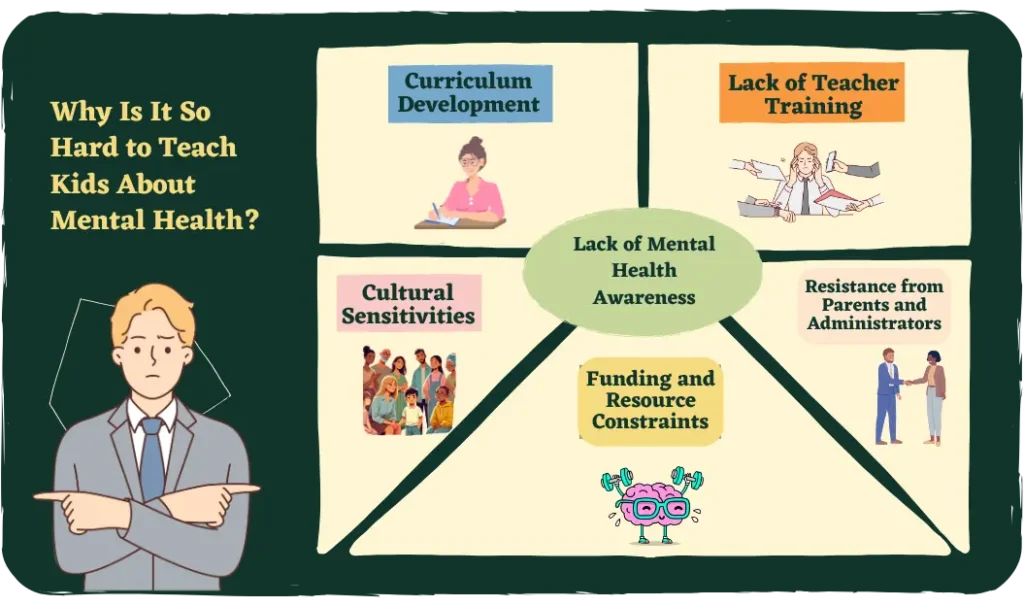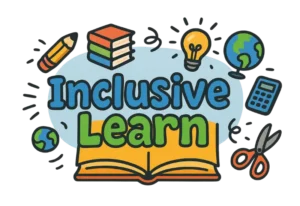We don’t teach young children about mental health largely due to societal stigma, misconceptions about childhood resilience, and the education system’s focus on academics. For the full story on why this gap exists and how it impacts the next generation, keep reading below.
The Current Landscape of Mental Health in Young Children
Did you know that 1 in 7 children aged 3–17 in the U.S. experience a mental health disorder each year? Despite this, discussions about mental health in early education remain rare.
Mental Health Trends in Children
- Increasing Prevalence: Studies show a 65% rise in mental health-related hospitalizations for children over the past decade.
- Early Onset: Approximately 50% of mental health conditions develop by age 14, making early intervention critical.
“Children’s mental health is a key part of their overall development and well-being, yet we often wait until it’s too late to address it,” says Dr. Jamie Howard, a clinical psychologist.
Why Early Childhood is a Critical Window
- During early years, children form the building blocks for emotional regulation, empathy, and resilience.
- Without early intervention, unresolved emotional struggles can lead to academic challenges, behavioral issues, and long-term health effects.
Case Study
A 7-year-old struggling with anxiety and attention issues went undiagnosed until third grade. Early recognition and treatment for mental health conditions like anxiety and depression are crucial for children’s academic and social well-being. Unfortunately, many children don’t receive help until symptoms significantly impact their lives.
Societal Norms and Stigma
Mental health remains a sensitive topic in many societies, often shrouded in stigma and misconceptions. This silence perpetuates the idea that children are too young or innocent to understand mental health, which delays vital conversations.
Why Stigma Persists
- Taboo Nature: Mental health issues are still seen as a personal failing or weakness in many cultures, making open discussions difficult.
- Generational Beliefs: Older generations may dismiss mental health struggles as something children will “grow out of.”
- Fear of Labeling: Some parents and educators worry that discussing mental health with children might “plant ideas” in their heads or cause undue stress.
“We don’t hesitate to teach kids about physical health, so why not mental health? The brain is part of the body, after all.” – Unknown Educator
Common Misconceptions About Childhood Resilience
- “Kids Are Too Young to Have Mental Health Problems”: This belief assumes children can’t experience anxiety, depression, or other issues, despite evidence to the contrary.
- “Kids Bounce Back Easily”: While children can be adaptable, prolonged emotional struggles can leave lasting effects without proper support.
- “They Won’t Understand”: Experts argue that children are capable of understanding emotions and mental well-being when taught in age-appropriate ways.
The Impact of Stigma
Stigma surrounding mental health creates a cycle where children don’t receive the help they need early on, increasing the risk of:
- Emotional challenges becoming entrenched.
- Difficulty forming healthy coping mechanisms.
- Future reluctance to seek help as adults.
Prioritization Within the Education System
Academic Over Emotional Well-being
Modern education systems prioritize measurable academic outcomes like test scores and literacy rates over emotional development. This focus often sidelines mental health education.
Why Mental Health Takes a Backseat:
- Curriculum Pressures: Teachers are under immense pressure to meet academic benchmarks, leaving little room for emotional and mental health topics.
- Lack of Training: Many educators feel unprepared to address mental health issues or teach emotional regulation.
- Perceived “Extras”: Mental health discussions are often seen as optional or a secondary concern, rather than integral to a child’s development.
The Consequences
Failing to address mental health in schools leads to:
- Increased bullying and peer conflicts.
- Rising rates of school absenteeism due to anxiety and depression.
- Decreased academic performance among children struggling with emotional issues.
“Teaching mental health isn’t a distraction from academics, it’s a foundation for success.” – Educational Psychologist
Statistics Snapshot
| Area of Focus | Hours Spent Per Year (Avg.) |
| Math | 180 |
| Mental Health Education | <10 |
Parental and Community Hesitations
Parents and caregivers often play a critical role in shaping a child’s understanding of mental health, but their own fears and misconceptions can inadvertently create barriers to early education.
Why Parents Are Reluctant
- Fear of Overwhelming Children: Many parents believe that discussing mental health will confuse or worry their child unnecessarily.
- Lack of Knowledge: Parents may feel they don’t know enough about mental health to discuss it effectively.
- Cultural Beliefs: In some communities, mental health is associated with shame or weakness, discouraging open conversations.
“I want to talk to my child about emotions, but I don’t even know where to begin,” shared a concerned parent during a mental health awareness workshop.
Community-Level Challenges
- Resistance to Change: Communities that view emotional struggles as private matters may oppose teaching mental health in schools.
- Unequal Resources: In underprivileged areas, mental health awareness programs and access to support are often limited.
The Result of Hesitation
When parents and communities avoid mental health discussions, children are left to:
- Internalize their struggles without understanding them.
- Feel isolated or abnormal when experiencing strong emotions.
- Miss the opportunity to develop healthy coping strategies early in life.
Assumptions About Age Appropriateness
One of the most pervasive barriers to teaching young children about mental health is the belief that they are too young to understand such complex topics.
Debunking the Myths
- Children Can’t Understand Mental Health Concepts: While it’s true that abstract ideas may be challenging, children are highly capable of understanding emotions like happiness, sadness, anger, and worry.
- It’s Better to Shield Children from Tough Topics: Shielding children from conversations about emotions doesn’t protect them—it leaves them unequipped to manage those feelings when they arise.
“Children as young as three can learn to identify their emotions and talk about what they’re feeling,” says Dr. Lisa Damour, child psychologist and author.
Why These Assumptions Are Harmful
- They prevent children from learning basic emotional vocabulary, making it harder to articulate their needs.
- They delay the development of self-awareness and empathy, key skills for social and emotional growth.
Practical Example
Imagine teaching a 5-year-old about feelings with a simple storybook like The Color Monster by Anna Llenas, which explains emotions using colors. This kind of tool shows that even complex topics like emotional regulation can be introduced in age-appropriate ways.
Arguments Against Early Mental Health Education
Despite the growing awareness of the importance of mental health, some parents, educators, and policymakers remain skeptical about introducing these topics to young children.
Key Concerns
- Children Lack the Maturity to Understand Mental Health
Critics argue that children are not cognitively equipped to grasp abstract concepts like mental health, fearing it might lead to misunderstandings or unnecessary worry.- Counterpoint: Children don’t need to learn about clinical terms or diagnoses. Instead, age-appropriate lessons on emotions and coping strategies can form the foundation for better understanding later in life.
- Fear of Overcomplication
Some parents and educators worry that discussing mental health with young children will introduce unnecessary complexity to their lives.- Counterpoint: Introducing mental health education doesn’t mean burdening children with adult-level concepts. For example, teaching kids to name their feelings or practice mindfulness can be simple and enjoyable.
- Focus on Academic Skills
In a system already burdened with academic benchmarks, mental health education is often perceived as a distraction from core subjects like math, reading, and science.- Counterpoint: Studies show that emotional well-being improves academic performance. Teaching kids emotional regulation skills can help them focus better and handle stress during tests or assignments.
The Risks of Avoiding Early Mental Health Education
- Ignoring emotional health can lead to increased anxiety, behavioral issues, and difficulty forming relationships.
- Children without coping mechanisms may struggle with emotional outbursts, conflict resolution, and stress management.
“Not teaching kids about mental health is like sending them out into the world without teaching them to read. It’s a life skill, not a luxury,” says educational consultant Maria Thomason.
The Case for Early Mental Health Education
Building Resilience
Teaching mental health concepts to children equips them with tools to handle challenges, making them more resilient in the face of life’s inevitable ups and downs.
- For example, children who learn to identify stress can use strategies like deep breathing or asking for help.
Preventing Escalation
Addressing mental health early can help prevent small emotional challenges from turning into bigger issues later in life.
- Early intervention has been shown to reduce the risk of depression, anxiety, and other mental health disorders in adulthood.
Reducing Stigma
By normalizing conversations about mental health from a young age, we can create a generation that is more empathetic and open about seeking help.
- Studies suggest that children exposed to mental health education are more likely to reach out to a trusted adult when experiencing distress.
Developing Emotional Intelligence
When children understand their feelings, they can:
- Build stronger relationships with peers.
- Communicate their needs more effectively.
- Navigate difficult situations without becoming overwhelmed.
“Mental health education doesn’t just prepare kids for school—it prepares them for life,” says Dr. Carla Jones, a child psychologist specializing in early intervention.
Challenges in Implementation
While the benefits of teaching young children about mental health are clear, implementing mental health education comes with several practical and systemic challenges.

1. Curriculum Development
Designing age-appropriate mental health lessons is a complex process. Educators and experts must ensure the material:
- Uses child-friendly language and relatable examples.
- Addresses emotional concepts without overwhelming children.
- Aligns with existing curriculum standards to avoid disruption.
Example: Creating lessons like identifying emotions through activities, such as coloring faces or storytelling, can make the topic approachable and engaging for young learners.
2. Lack of Training for Educators
Teachers often lack the training or confidence to discuss mental health in the classroom. Many educators report feeling unprepared to:
- Address emotional struggles that children express during lessons.
- Integrate mental health concepts into their teaching without additional guidance.
Solution: Offering professional development programs for teachers can empower them to effectively introduce mental health topics. For example, short certification courses on child psychology and emotional intelligence can help bridge this gap.
3. Cultural Sensitivities
Mental health education must navigate cultural beliefs and values that may conflict with open discussions about emotions or mental well-being.
- Challenge: In some cultures, discussing mental health openly is seen as taboo, leading to resistance from parents and community members.
- Solution: Tailoring mental health programs to reflect the cultural context of the community can make them more acceptable.
4. Funding and Resource Constraints
Budget constraints in schools often push mental health education to the back burner.
- Many schools struggle to afford counseling programs, let alone introduce a mental health curriculum.
- A lack of mental health professionals in schools exacerbates the problem, with the U.S. reporting an average student-to-counselor ratio of 424:1.
Fact: According to the National Association of School Psychologists, the recommended ratio is 250:1, making the current state far from ideal.
5. Resistance from Parents and Administrators
Some parents and school administrators may oppose mental health education due to:
- Misconceptions that it’s unnecessary or inappropriate for young children.
- Concerns that it will take time away from core academic subjects.
“Convincing stakeholders that mental health is as important as literacy is a challenge we must tackle,” says educational consultant Rachel Fernandez.
Potential Solutions and Strategies
To address the challenges of teaching young children about mental health, implementing practical solutions can make this critical education more accessible and effective.
1. Normalize Emotional Vocabulary
- Introduce simple terms like “happy,” “sad,” “worried,” and “calm” to help children articulate their feelings.
- Use tools like emotion charts, where children can point to how they feel, encouraging self-awareness and emotional expression.
Example Activity: Start a “Feelings Circle” each morning where children share one word about how they feel. This activity builds emotional vocabulary and fosters a supportive environment.
2. Use Play-Based Learning
- Games, storytelling, and role-playing make learning about mental health engaging and age-appropriate.
- Interactive tools like puppets, drawing, and music can help children process emotions without pressure.
According to a study published on PubMed, a micro-randomized trial found that slow-paced diaphragmatic breathing was beneficial for children aged 9-13 years, particularly those with higher levels of worry, leading to increased relaxation, even though it did not have immediate effects on negative emotions or relaxation in general.
3. Incorporate Mental Health Into Existing Subjects
Mental health education doesn’t need to be a separate subject—it can be seamlessly integrated into:
- Literature: Use storybooks featuring characters navigating emotions to discuss empathy and problem-solving.
- Art: Encourage children to express feelings through drawing, painting, or crafting.
- Physical Education: Teach relaxation techniques like stretching or yoga to promote mental and physical well-being.
Example: Reading a story like Alexander and the Terrible, Horrible, No Good, Very Bad Day can spark a discussion about managing bad moods.
4. Parental Involvement
Equip parents with resources to continue mental health discussions at home.
- Host workshops or send home activity guides on topics like “how to talk about feelings” or “calm-down strategies.”
- Encourage parents to model healthy emotional behaviors, such as acknowledging their own stress and showing how they manage it.
Tip: Apps like Smiling Mind offer free, easy-to-use mindfulness exercises for children and parents to practice together.
5. Promote Representation in Media
Children’s media is a powerful tool for normalizing mental health conversations. Promote and use:
- Books: Titles like The Invisible String (on coping with loss) or When Sophie Gets Angry—Really, Really Angry (on managing anger).
- TV Shows: Programs like Daniel Tiger’s Neighborhood that teach kids about emotions through relatable scenarios.
Fun Fact: Research shows that kids who watch emotionally intelligent characters in media are more likely to practice empathy and kindness.
6. Invest in Teacher Training
Teachers need support to effectively introduce mental health topics. Provide:
- Workshops: Short courses on child psychology and emotional intelligence.
- Lesson Plans: Pre-made, easy-to-implement lesson plans focused on mental health concepts.
Example Program: A pilot program in New York provided teachers with a six-week emotional wellness training. Afterward, 85% of participants reported feeling more confident addressing children’s emotional needs.
7. Advocate for Policy Changes
Encourage policymakers to:
- Include mental health education in school curriculums as a core subject.
- Allocate funding to hire more school counselors and provide mental health resources.
Actionable Idea: Join local or national campaigns advocating for better mental health funding in schools. Organizations like Mental Health America regularly push for these reforms.
The Big Picture
By normalizing discussions about emotions, using engaging teaching tools, and involving parents and teachers, we can build a strong foundation for children’s mental health education. These strategies not only address current challenges but also pave the way for a brighter, emotionally intelligent future generation.
Conclusion: Start the Conversation Early
Teaching mental health to young children builds emotional resilience, reduces stigma, and equips them with life-long skills. While challenges like stigma and funding exist, solutions like play-based learning and parental involvement make it achievable. It’s time we prioritize mental health education, because happy, healthy children grow into thriving adults.


